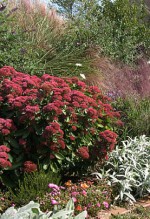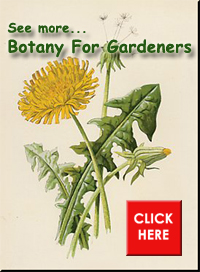 All plants have Latin names consisting of a genus name and a species name. The species name is the second of the two names, is usually not capitalized and describes some characteristic of the plant. For example, the Latin name for ordinary bugleweed is Ajuga reptans; the species name, reptans is tells us something about bugleweed and if you know Latin you might remember that it means creeping. Ajuga reptans has stolons that creep in the soil rapidly spreading the plants in the garden and lawn, so this Latin name tells you something very important. The real bonus is that you don’t have to know the plant at all to know something significant about it.
All plants have Latin names consisting of a genus name and a species name. The species name is the second of the two names, is usually not capitalized and describes some characteristic of the plant. For example, the Latin name for ordinary bugleweed is Ajuga reptans; the species name, reptans is tells us something about bugleweed and if you know Latin you might remember that it means creeping. Ajuga reptans has stolons that creep in the soil rapidly spreading the plants in the garden and lawn, so this Latin name tells you something very important. The real bonus is that you don’t have to know the plant at all to know something significant about it.
The species name can tell you many interesting facts about the plant including: the color, size, or shape of the flower; the color, texture, size, shape of the leaf; or the origin, height, or habitat of the entire plant. Sometimes you can derive the English meaning of the Latin word by noting the similarity between the English and Latin (after all, 60% of English words come from Latin). For example, Acanthus spinosus; the species name, spinosus, looks like spine and guess what? This bear’s breeches has spines on its leaves. If the name of a plant is Pistacia chinensis you would have no trouble recognizing that it originally came from China.
Here are some commonly used species names and their English meanings. I have grouped them by category for ease in learning but I have included and alphabetical listing at the end of the post for ease of using them. Note that in most cases the name ends in –a. In Latin, all nouns have a gender; masculine, feminine, or neuter. The adjectives that go with them have to agree in gender. The feminine gender ends in -a and is the most common so I have put all the species name possible in the feminine gender, ending in -a but the same word could end in -us, or -um and still mean the same thing. Thus, alba, albus, album all mean white.
Geographic region where originally found (the –is ending of these indicates possession so the word can be translated “of ….”)
canadensis: from Canada or the northeastern US
chinensis: from China
japonica: from Japan
missouriensis; from Missouri
occidentalis: from the East
Habitat:
maritime: of the sea
montane: mountain
muralis: growing on a wall
palustris: from a bog
rivalis: from a river
saxatilis: from rocks/rocky place
sylvestris: of the woods
Color:
azurea: blue
aurea: yellow (refers to foliage)
alba: white
argentea: silvery
lutea: yellow (refers to flowers)
maculata: spotted
niger: dark
phoenicea: purple
purpurea: deep pink
rubra: red
sanguinea: blood red
viridis: green
Shape/Form:
campanulata: bell shaped
pendula: hanging
reptans: creepng
spicata: spike
stellata: starlike
stricta: upright
Texture:
farinose: flowery, powdery
glabra: smooth
glutinosa: sticky
pubescens: hairy
rugosa: wrinkled
spinosa: spiny
tomentosa: wooly
Size:
altissimus: tallest
angustus: narrow
granda: large
majus: larger
maxima: biggest
nana: very small
pumila: dwarf
Miscelaneous:
edulis: edible
foetida: bad smelling
odorata: perfumed
officindis: with herbal uses
sativa: cultivated
semperviva: always green=evergreen
vulgaris: common
Prefixes:
lati-: wide
macro-: large
micro-: small
parvi-: small
pauci: few
poly-: many
Suffixes:
-flora: flower
-folia: leaf
When examining a species name always try to identify the derivative because that is the easiest way to deal with it. Over time as you notice the Latin names you will become more comfortable with them and add meanings. The process is really fun and here is a little quiz-game to get you started. Answers are at the end of the post.
Multiple Choice: Pick the best answer. All of these can be figured out using information given by the species name. You DO NOT need to know the plant.
1. Corydalis lutea probably has a. spines b. a sticky stem c. small leaves d. yellow flowers
2.3. If you want a fragrant bouquet your first pick should be a. Helleborus foetidus b. Heuchera villosa c. Lathyrys odorata d. Geranium sanguineum
4. Lavandula latifolia probably has a. small flowers b. small leaves c. wide leaves d. bell shaped flowers
5. You would be most likely to find Myosotis palustris growing a. in a desert b. among rocks c. on a wall d. in a bog
6. If a friend gave you Boletus edulis you should a. throw it out immediately b. use it in a pasta dish c. smoke it d. rub it on your fingernails
7. Melissa officinalis is used as a/n a. vegetable b. fruit c. building material d. herb
8. To describe its wrinkled leaves a plant is most likely to have the species name a. glutinosa b. rugosa c. glabra d. coccinea
9. When looking for a plant for a rock garden a good choice would be a plant with the species name a. muralis b. stellata c. saxatilis d. sativa
10. Achillea tomentosa probably has a. wooly foliage b. blood red leaves in fall c. short stems d. huge root system
Alphbetical listing of Latin species names:
alba: white
altissimus: tallest
angustus: narrow
argentea: silvery
aurea: yellow (refers to foliage)
azurea: blue
campanulata: bell shaped
canadensis: from Canada or the northeastern US
chinensis: from China
edulis: edible
farinose: flowery, powdery
-flora: flower
foetida: bad smelling
-folia: leaf
glabra: smooth
glutinosa: sticky
granda: large
japonica: from Japan
lati-: wide
lutea: yellow (refers to flowers)
macro-: large
maculata: spotted
majus: larger
maritime: of the sea
maxima biggest
micro-: small
missouriensis: from Missouri
montane: mountain
muralis: growing on a wall
nana: very small
niger: dark
occidentalis: from the East
odorata: perfumed
officindis: with herbal uses
palustris: from a bog
parvi-: small
pauci: few
pendula: hanging
phoenicea: purple
poly-: many
pubescens: hairy
pumila: dwarf
purpurea: deep pink
reptans: creepng
rivalis: from a river
rubra: red
rugosa: wrinkled
sanguinea: blood red
sativa: cultivated
saxatilis: from rocks/rocky place
semperviva: always green=evergreen
spicata: spike
spinosa: spiny
stellata: starlike
stricta: upright
sylvestris: of the woods
tomentosa: wooly
viridis: green
vulgaris: common
 Answers:
Answers:
1. d. lutea means yellow
2. b. orientalis refers to Asia
3. c. odorata means perfumed; note that foetidus means foul smelling
4. c. latifolia is a combination of lat- meaning wide and -folia meaning leaf
5. d pulustis means of a bog
6. b. Bletus edulis is an edible mushroom
7. d. officinalis indicates that the plant is an herb
8. b. rugosa means wrinkled; a great example is Rosa rugosa that has very distinct looking and disease resistant foliage.
9. c. saxitalis refers to rocks.
10. a. tormentosus means wooly
The teacher in you came out again. Great article. I learned a lot and had fun, too! I’m going to print this one out and bring it with me when I go to the Arb.
Yes, I will always love teaching and especially teaching Latin.
[…] Botanical Latin: Species Names […]